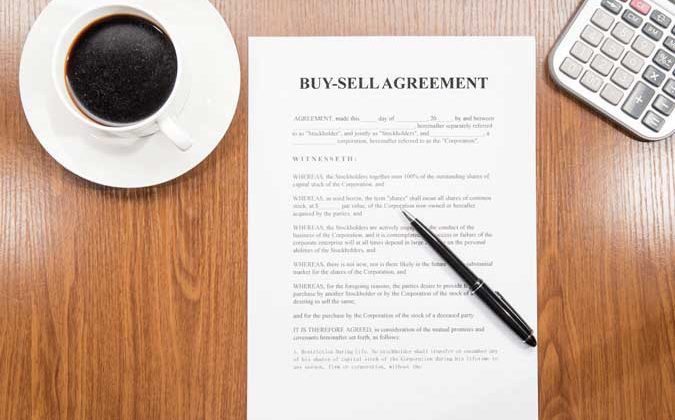
A Buy-Sell Agreement assures a smooth transition of ownership and business continuity in the event of a departure of a partner or equity owner. It is a legally binding contract that establishes how the departing owners’ shares may be reassigned (obtained by the remaining partners) should that owner die or otherwise leave the business involuntarily, such as by death, disability, insanity, or bankruptcy. It typically also provides a mechanism for an orderly business succession should an owner decide to transfer his interest due to a voluntarily event, such as retirement. Any such event is referred to in the context of a Buy-Sell Agreement as a triggering event. They are also commonly drafted to restrict owners from selling their interests to outside investors without approval from the remaining owners.
Without such an agreement, there can be legal battles and contestation. For example, if a partner dies without an agreement, their shares may be passed automatically to their spouse, who may decide to keep them. Or, the spouse may want to sell them, but the remaining partners do not have the funds available to buy the shares, resulting in the spouse turning to an outsider.
In addition to controlling ownership of the business, Buy-Sell Agreements spell out the means to be used in assessing the value of a partner’s share. This can have uses outside the question of buying and selling shares. For example, if there is a dispute among owners about the value of the company or of a partner’s interest, the valuation methods included in the buy and sell agreement would be used.
The two most common types of Buy-Sell Agreements are Entity-Purchase and Cross-Purchase Agreements. Under an Entity-Purchase Agreement, the business purchases an owner’s entire interest at an agreed-upon price if-and-when a triggering event occurs. If the business is a corporation, the plan is referred to as a Stock Redemption Agreement. In the context of a partnership, it is called a Liquidation of Interest.
Life or disability insurance is often used as a funding source within Agreements. The business owns and is the beneficiary of insurance on the lives of each stockholder, and upon death or disability, it uses the proceeds to purchase back that individual’s share of ownership. If whole life insurance with cash value is used as part of the Agreement, the cash value is recorded as an asset of the business on the balance sheet. It is important to note that, depending on the structure of the corporation, there are different tax implications to consider when using an entity-purchase plan.
The use of a Cross-Purchase arrangement requires each stockholder to purchase and own life insurance on the lives of the other stockholders. Each owner would pay the premiums and be the beneficiary of the policy. The face amount of the insurance would be calculated based on the other’s ownership interest. Upon the death of one owner, the insurance proceeds would be used to purchase the ownership interests from the deceased owner’s estate or family.
Sometimes, a “Trusted” Cross-Purchase arrangement is preferred in which a trust would own one policy on each Partner/Owner and represent the others in the transaction, eventually distributing the deceased individual’s ownership to the remaining partners/owners. Disability buy-sell insurance can also be used in a Cross-Purchase Agreement to facilitate transfer of ownership upon the total disability of one of the individuals.
Business continuity is important, especially when there are multiple partners or important equity holders involved in the running of a business. A Buy-Sell Agreement is a legal remedy for establishing a clear plan of how to distribute the shares of a departed or deceased partner to the remaining ones. In the case of a death, life insurance policies are used to fund the buyout of shares from the deceased’s estate.
***
Eric S. Degen. CPA Titan Accountancy, LLC
discover the advantages of excellence
